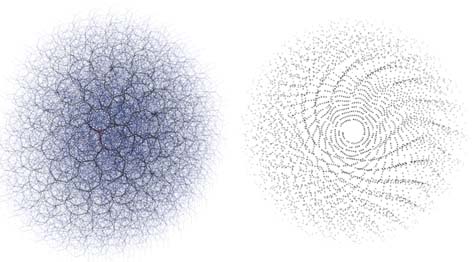New exhibit melds art and technology

This is a piece from Jean-Pierre Hébert’s exhibit, Drawings as Thoughts, at the
Southern California Institute of Architecture.
By Daily Bruin Staff
Oct. 18, 2009 10:06 p.m.
UCLA students typically identify themselves as artistic or scientific ““ usually one or the other. The artist Jean-Pierre Hébert is one of the few people that can label himself as both artistic and scientific .
The artwork of Jean-Pierre Hébert at The Southern California Institute of Architecture shows that the separation between art and science can be bridged. The exhibition, which opens Oct. 23, is called “Drawings as Thoughts” and focuses on ideas of time, line and the influence of architecture as expressed through Hébert’s spectacular computer generated work.
Born in Calais, France, Hébert was drawn to the arts and was especially attracted to drawing. However, Hébert followed the path of his family members to engineering school. This gave him the technical background that he would later apply to his work. He currently is the artist-in-residence at the Kavli Institute for Theoretical Physics at UC Santa Barbara.
Hébert worked at IBM on the first computer, IMB704 in 1959. It was during this time at IBM that he first saw a small computer generated image.
“I felt (computer-generated drawing) was something I could easily do,” Hébert said.
This interest in newly emergent technology began his artistic career, and Hébert eventually became a pioneer of this unconventional art form.
“There are very few people that pursue this form of art with such clarity, connecting mathematical concepts with art and tactile sensibility,” said Jean Michel Crettaz, a SCI-Arc faculty member and program coordinator of SCI-Arc’s Mediascapes.
For each piece of art, Hébert creates a unique computer code. He does not use software or a mouse. When he first began his work computers didn’t have screens; it was completely trial and error.
“Hébert uses the computer as another tool, a brush, a way to get texture. He never lets the computer direct his work,” said Elaine Levasseur, a colleague of Hébert.
Levasseur said Hébert’s work is constantly evolving due to influence by different ideas and inspirations. His work is affected by the constant changing nature of the computer. He began his work when computers and printers were extremely unreliable.
“The process was incredibly nerve-racking and full of anxiety. I experienced a lot of bad and good surprises,” Hébert said.
Time and innovation have made the medium much more constant and have allowed Hébert to better embrace the creative process without disturbance.
The exhibition takes its inspiration from the gallery itself. Since the exhibition is taking place in the library of the architecture school, Hébert incorporates the architecture and the different spaces of the library.
“The work is unusual because he is interested in line and all its meanings in reality and metaphor. It is an essential idea because a line is the basic metaphor of being human,” Levasseur said.
This use of line will take many different forms throughout the different pieces in the exhibition.
One series entitled “Waiting for Pritzker” uses subliminal text within the work to list the recipients of the Pritzker Prize, which is a prestigious award given for greatness in architecture. Another piece uses text as line. In this piece, the text comes from critical architecture books. These pieces merge Hébert’s continuing line fascination with the influence of architecture.
Time is another key influence in Hébert’s work. He is showcasing a real-time piece of art that will evolve before the eyes of the viewer. It is pre-programmed and will be projected on the wall of the gallery.
“It will be a line drawing, a curve drawing. It will be arranged by the geometry of time, like as a clock turns. Just as time never repeats itself this will never repeat itself,” Hébert said.
Not only is the piece dynamic it will morph in style over time because as Hébert said, “I do not like boring drawings.”
The exhibit is also unique because it is being displayed in SCI-Arcs library and doesn’t have the typical open spaces of a gallery.
“The space lends itself to small pieces which create a intimate feel, which allows you to be close to the material,” Hébert said.
Seating areas also provide the opportunity to take in a series of drawings that looks at line as it evolves from weak to strong.
“I have never before met an artist who is so much more than art. The work is evidence of what is going on in this guy’s head,” Levasseur said.
The exhibition is only a small slice of Hébert’s wide body of work, which includes collaborations with physicists and musicians.
“In this very rare situation, this is where a little research will give more interest and pleasure when viewing the work,” Levasseur said.


